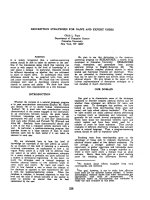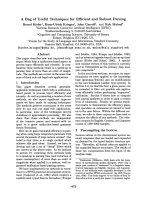Qa for ihc and ish use
Bạn đang xem bản rút gọn của tài liệu. Xem và tải ngay bản đầy đủ của tài liệu tại đây (5.54 MB, 76 trang )
QUALITY ASSURANCE,
QUALITY CONTROL AND
EXTERNAL QUALITY
ASSESSMENT
Anthony Rhodes, PhD, FRCPath, FIBMS
(UK NEQAS Manager, 1992-2003)
SUMMARY
• Definitions of QA, QC and EQA
• Relevance to Pathology and in particular Immunohistochemistry (IHC) and
In Situ Hybridisation (ISH)
• QA and Laboratory Accreditation
• QC for IHC and ISH
• EQA for IHC and ISH
• What happens when you don’t have QA?
• National and International guidelines for assuring quality
• Technical and Clinical Validation
• Standardisation
QUALITY ASSURANCE
• Quality assurance (QA) encompasses all measures taken to ensure the
reliability of investigations, starting from satisfactory test sample selection,
analysing it appropriately, to recording the result accurately and reporting it
to the clinician for appropriate action, with all procedures being
documented for reference (UK NEQAS, 1998).
• In the clinical laboratory, QA is usually provided by participation in a
Laboratory Accreditation Programme.
LABORATORY ACCREDITATION
• Can be national or international, or both
• Involves registering with an approved accreditation programme
• Documentation of all the procedures in the laboratory, to include;
• Range of tests, SOP’s, turn around times, results of audits, adherence to good
laboratory practice and international guide lines (e.g. ASCO/CAP guidelines),
details of procurement, maintenance and servicing of all equipment, records
of QC, participation and performance in EQA/Performance Testing (PT) etc.
• Visit by inspectors that thoroughly inspect the lab, interview the staff,
review the documentation and record whether compliant or noncompliant,
• Laboratory is given a time interval (e.g. months), to address areas of noncompliance and provide evidence that it is now compliant.
• Laboratory is then give accreditation for a given time period
QUALITY ASSURANCE (QA)
Two of the main features of QA are;
• Internal Quality Control (IQC)
AND
• External Quality Assessment
Performance Testing (PT)
(EQA),
sometimes
named
INTERNAL QUALITY CONTROL
(IQC)
• The set of procedures undertaken for the continual evaluation of the quality
of results on a day-to-day basis, in order to decide on whether they are
reliable enough to be released (WHO, 1981, Leblanc et al., 1985).
INTERNAL QUALITY CONTROL
Factors to consider;
•
Fixation (pre-analytical)
•
The assay (analysis)
•
Evaluation of the results (post analysis)
INTERNAL QUALITY CONTROL
Factors to consider;
•
Fixation (pre-analytical)
•
The assay (analysis)
•
Evaluation of the results (post analysis)
FIXATION
CLASSIFICATION (HOPWOOD (2002) &
BAKER (1960)
1.Aldehydes e.g. formaldehyde, glutaraldehyde (all non-coagulant)
2.Oxidising agents: osmium tetroxide, potassium dichromate (non –
coagulant)
3.Protein-denaturing (coagulant): acetone, acetic acid, methyl alcohol,
ethyl alcohol
4.Physical: Heat, microwaves (coagulant)
5.Miscellaneous: Mercuric chloride, picric acid, (coagulants)
COAGULATED
PROTEIN
NON- COAGULATED
PROTEIN
RECOMMENDED FIXATION FOR CLINICAL
PATHOLOGY
Neutral Buffered Formalin (pH 7.0) for 24-48 hours, ensures suitable for IHC
and molecular techniques such as FISH.
TIME BEFORE FIXATION:
Warm and Cold Ischemic Time
DELAY BEFORE FIXATION
• There should be minimal delay following surgical removal
• Tissue sliced, to allow for even fixation, preservation of areas in the centre of
specimen
• Neutral Buffered Formalin (pH 7.0) for 24-48 hours, ensures suitable for IHC
and molecular techniques such as FISH.
ER
0 hours
4 hours
8 hours
o/night
PR
0 hours
1 hours
4 hours
8 hours
IMPORTANCE OF FIXATION
FOR APPROPRIATE TIME.
Am J Clin Pathol 2003; 120: 66-92.
INTERNAL QUALITY CONTROL
Factors to consider;
•
Fixation (pre-analytical)
•
The assay (analysis)
•
Evaluation of the results (post analysis)
THE ASSAY
• Positive control; do we need a positive control slide?
• Placed on the same slide, or as additional slides?
• Fixation – Ideally the tissue used as a control should have undergone
identical fixation as the test case –otherwise there is potential for a false
negative result (if control fixed less than the test) or a false positive result (if
control fixed longer than the test)
• Negative controls; do we need them – Some labs use them, some do not!
IMMUNOHISTOCHEMISTRY (NEGATIVE
CONTROLS)
EVALUATION
Diagnostic interpretation of results
and/or scoring of slides.
TECHNICAL ASPECTS OF ASSAY
Px
Px
Px
5) VISUALIZATION OF PEROXIDASE LABEL
4) BINDING OF TERTIARY LAYER
3) SECONDARY ANTIBODY BINDING
2) OMISSION OF PRIMARY ANTIBODY
1) TISSUE FIXATION, EXPOSURE OF
EPITOPES (ANTIGEN RETRIEVAL)
FLUORESCENT IN SITU HYBRIDISATION (FISH)
OR CHROMOGENIC IN SITU HYBRIDISATION
(CISH)
Chromogenic or Fluorescent signal
G – C – T – C – A – G - A Probe with complimentary
base pair sequence
HER2 gene sequence
C – G – A – G – T – C - T Tissue section
Microscope slide









